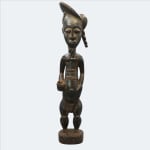Baule Blolo Bian (Spirit Husband) Figure, Nineteenth to Twentieth Century AD
Wood, Fibre
41.2 x 7.5 x 7 cm
16 1/4 x 3 x 2 3/4 in
16 1/4 x 3 x 2 3/4 in
CC.42
Further images
-
(View a larger image of thumbnail 1
)

-
(View a larger image of thumbnail 2
)

-
(View a larger image of thumbnail 3
)

-
(View a larger image of thumbnail 4
)

-
(View a larger image of thumbnail 5
)

-
(View a larger image of thumbnail 6
)

-
(View a larger image of thumbnail 7
)

-
(View a larger image of thumbnail 8
)

-
(View a larger image of thumbnail 9
)

The Baule people of modern-day Côte d'Ivoire (Ivory Coast) believe that before a person is born, they reside in blolo, the Spirit World. There, every spirit is married, but when...
The Baule people of modern-day Côte d'Ivoire (Ivory Coast) believe that before a person is born, they reside in blolo, the Spirit World. There, every spirit is married, but when the individual is born, they leave their Spirit Husband (blolo bian) or Spirit Wife (blolo bla) behind. In the other world, these spirit lovers can become jealous or angry; in this case, misfortune might befall an individual. The only way to remedy the situation is to devote a shrine (tata) in the private part of the house, and to place upon it a figure of the spirit lover. There it was regularly oiled, appointed with clothes and jewellery, and treated with reverence. Only its owner could look upon it; if it was displayed to visitors, it was customary for them to be looked upon surreptitiously with a ritual glance known as nian klekle.
This Spirit Husband figure has a long ovoid face with a slender nose, wide eyes, and thick full lips. The round ears are high up the head. He has a complex hairstyle consisting of braids at the back and side, a disc shape on top, and a twisted sidelock. He also sports a long, twisted beard. His chest is small, with large nipples, and he has long slender arms held to the side of his elongated torso. His fingers are also long, and in his right hand he holds a cup or bowl. His stomach is large, and has a prominent navel. He wears a thong made from fibre, and has short stocky legs and small sharply rounded buttocks. He stands in a powerful pose, knees bent, as though ready for action. His body is covered in small squares, representing scarification, which was an important ritual of the Baule. They considered it a mark of civilization, separating humans from the naked, unadorned bodies of the animals. This piece is a companion to a Spirit Wife also in the Barakat Collection (CC.41).
The Baule are one of the Akan peoples; they arrived in the Ivory Coast in the eighteenth century, and adopted sculptural and mask-making traditions from their neighbours, the Guro, Senufo and Yaure peoples. Baule figures are among the most elegant and sculptural pieces from Africa. This piece shows a developed execution of the face, hair and scarification. It served as a home for the spirit; when the spirit needed to be consulted, a diviner was brought in, and the spirit would be transferred from the statue to possess the diviner.
This Spirit Husband figure has a long ovoid face with a slender nose, wide eyes, and thick full lips. The round ears are high up the head. He has a complex hairstyle consisting of braids at the back and side, a disc shape on top, and a twisted sidelock. He also sports a long, twisted beard. His chest is small, with large nipples, and he has long slender arms held to the side of his elongated torso. His fingers are also long, and in his right hand he holds a cup or bowl. His stomach is large, and has a prominent navel. He wears a thong made from fibre, and has short stocky legs and small sharply rounded buttocks. He stands in a powerful pose, knees bent, as though ready for action. His body is covered in small squares, representing scarification, which was an important ritual of the Baule. They considered it a mark of civilization, separating humans from the naked, unadorned bodies of the animals. This piece is a companion to a Spirit Wife also in the Barakat Collection (CC.41).
The Baule are one of the Akan peoples; they arrived in the Ivory Coast in the eighteenth century, and adopted sculptural and mask-making traditions from their neighbours, the Guro, Senufo and Yaure peoples. Baule figures are among the most elegant and sculptural pieces from Africa. This piece shows a developed execution of the face, hair and scarification. It served as a home for the spirit; when the spirit needed to be consulted, a diviner was brought in, and the spirit would be transferred from the statue to possess the diviner.








